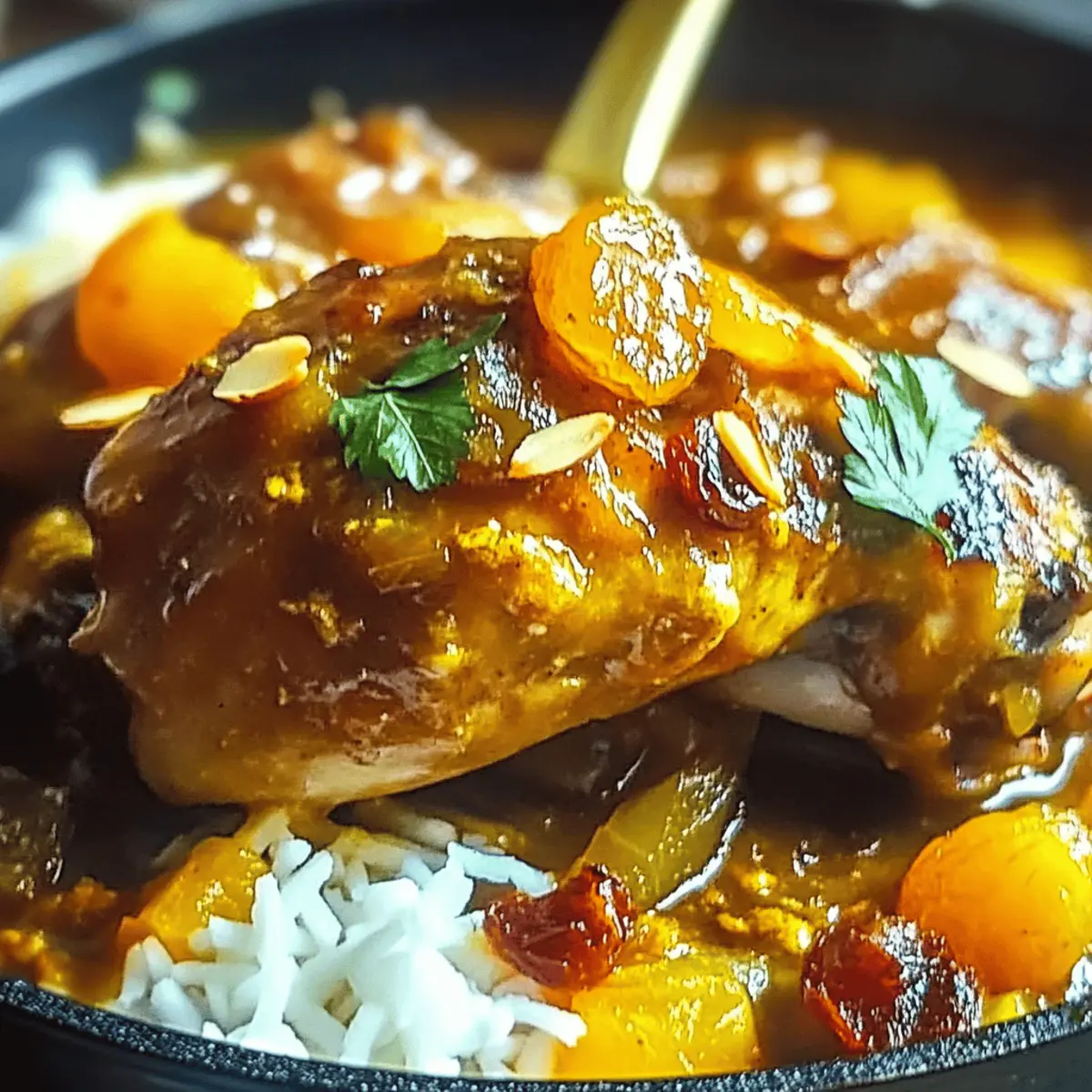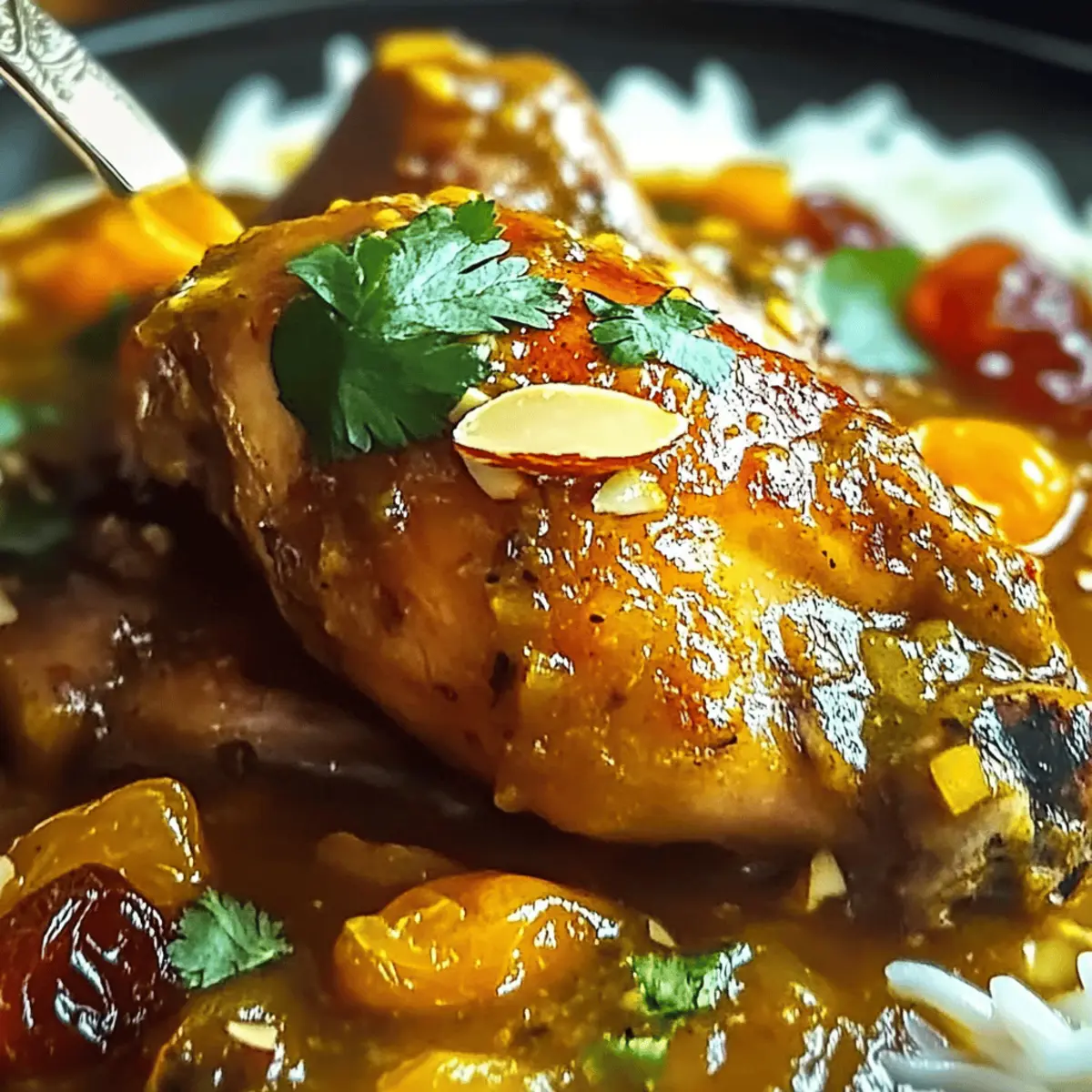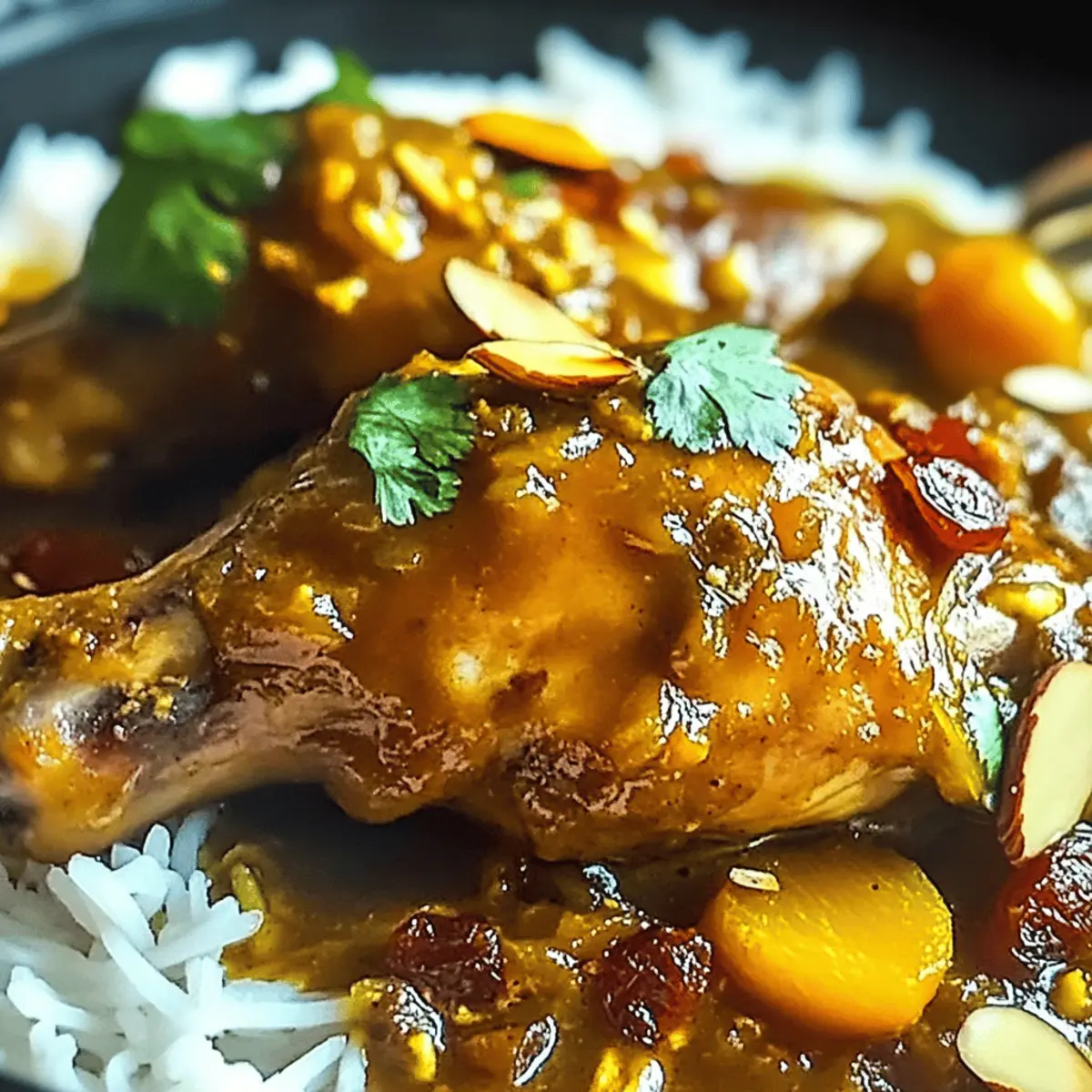In the midst of a bustling kitchen filled with intoxicating aromas, there’s a moment that stops you in your tracks—the warm, fragrant scent of Persian Chicken wafting through the air. This one-pot meal marries tender chicken with a delightful mix of spices that awaken your senses, while sweetness from dried apricots and crunch from toasted almonds make every bite an invitation to savor. What I love most about this dish is not just its rich flavors, but also how effortlessly it brings comfort to any gathering or quiet night in. Whether you’re feeding a hungry crowd or enjoying a cozy dinner for two, this Persian Chicken will quickly become a cherished favorite. Ready to dive into a symphony of delicious flavors? Let’s get cooking!

Why is Persian Chicken a Must-Try?
Simplicity: This one-pot meal is easy to prepare, making dinner effortless even on your busiest nights.
Rich Flavors: A tantalizing blend of spices and sweetness from dried apricots elevates the taste, ensuring every bite is memorable.
Comfort Food: Perfect for gatherings or cozy dinners, it provides warmth and satisfaction, delighting both friends and family.
Versatile Pairing: Serve it with fluffy basmati rice or warm naan, creating a hearty meal that soaks up all the delicious sauce.
Crowd-Pleaser: This Persian Chicken is sure to enchant everyone at your table, guaranteeing second helpings and smiles all around!
Persian Chicken Ingredients
For the Chicken
• Chicken – Four pieces (legs or thighs preferred); they provide protein and substance.
For the Aromatics
• Onion – 1 large, sliced; adds sweetness and depth of flavor.
• Garlic – 3 cloves, minced; enhances the aroma and overall flavor profile.
For the Cooking Base
• Olive Oil – 2 tablespoons; used for sautéing and adds richness.
• Turmeric Powder – 1 teaspoon; provides an earthy flavor and vibrant color.
• Ground Cumin – 1 teaspoon; contributes a warm, spicy note.
• Ground Cinnamon – 1 teaspoon; adds a touch of sweetness and warmth.
• Black Pepper – 1 teaspoon; introduces spiciness and depth.
• Salt – 1 tablespoon (adjust to taste); enhances all other flavors.
For the Moisture and Sweetness
• Fresh Lemon Juice – 2 tablespoons; adds acidity and brightness.
• Chicken Broth – 1 cup; provides moisture and depth to the dish.
• Dried Apricots or Prunes – 1 cup (or a mix); adds natural sweetness and delightful texture.
For the Crunch
• Toasted Almond Slivers – ½ cup; offers a satisfying crunchy element.
For Garnish
• Fresh Parsley or Cilantro – for garnish; adds freshness and a pop of color.
This Persian Chicken will transport you to a world of rich flavors and comforting aromas, making it a must-try in your culinary adventures!
Step‑by‑Step Instructions for Persian Chicken
Step 1: Prep the Chicken
Begin by rinsing four pieces of chicken (legs or thighs preferred) under cold water. Pat them dry using paper towels to ensure they are moisture-free, which will help them brown perfectly later on. Set your chicken pieces aside while you prepare the other ingredients for this delicious Persian Chicken.
Step 2: Cook Onions
In a large skillet or heavy-bottomed pot, heat 2 tablespoons of olive oil over medium heat. Add 1 large sliced onion and sauté for about 8–10 minutes, stirring occasionally until the onions turn golden brown and caramelized. This step builds a sweet flavor base for your Persian Chicken.
Step 3: Add Garlic and Spices
Once the onions are golden, add 3 minced garlic cloves to the skillet. Stir in 1 teaspoon each of turmeric powder, ground cumin, ground cinnamon, and black pepper, along with 1 tablespoon of salt. Cook for an additional 2–3 minutes until the mixture is fragrant, infusing the kitchen with the warmth of spices that define Persian Chicken.
Step 4: Brown Chicken
Increase the heat to medium-high and carefully add the chicken pieces to the skillet, skin-side down. Sear for about 5 minutes on each side until they are beautifully golden brown. This step not only enhances the flavor but also gives your Persian Chicken an inviting color as it cooks.
Step 5: Deglaze
After browning the chicken, reduce the heat slightly and pour in 2 tablespoons of fresh lemon juice. Use a wooden spoon to scrape any browned bits from the bottom of the skillet. This will help to create a rich, layered flavor in your Persian Chicken dish.
Step 6: Add Broth and Fruits
Next, pour in 1 cup of chicken broth along with 1 cup of dried apricots or prunes. Bring the mixture to a gentle simmer, allowing the flavors to meld together beautifully. As the liquids simmer, the dried fruits will soften, adding a sweet contrast to the savory spices.
Step 7: Cover and Cook
Reduce the heat to low and cover the skillet with a lid. Let the Persian Chicken simmer for 40 minutes, allowing the chicken to become tender and the flavors to deepen. This slow cooking method ensures that every bite is infused with deliciousness.
Step 8: Finish with Almonds
Uncover the skillet and fold in ½ cup of toasted almond slivers. Allow the mixture to cook for an additional 5-10 minutes until the sauce thickens to your preferred consistency. The toasted almonds will add a delightful crunch, enhancing the texture of your Persian Chicken.
Step 9: Rest
Once cooked, remove from heat and let your Persian Chicken rest for about 10 minutes. This short resting time allows the juices to redistribute, keeping the chicken succulent and flavorful when you serve it.
Step 10: Garnish and Serve
To serve, plate the chicken pieces and spoon the sauce over top. Garnish with fresh parsley or cilantro for a pop of color and freshness. Pair your Persian Chicken with fluffy basmati rice or warm naan for a comforting meal that’s sure to impress.

What to Serve with Persian Chicken?
Experience a harmonious blend of flavors, textures, and aromas to elevate your Persian Chicken into a delightful feast.
-
Fluffy Basmati Rice: The classic pairing absorbs the savory sauce beautifully while providing a light, fluffy texture that complements the succulent chicken.
-
Warm Naan Bread: Perfect for scooping up the rich sauce, this traditional bread adds a comforting, chewy element that enhances the meal’s authenticity.
-
Crisp Cucumber Salad: A refreshing salad with crisp cucumbers and vibrant herbs balances the meal’s rich flavors, providing a cool, crunchy contrast.
-
Roasted Vegetables: Seasonal roasted veggies, like carrots and bell peppers, add a sweet and earthy flavor, rounding out your plate with vibrant colors.
-
Mint Yogurt Sauce: This creamy, tangy dip brings a burst of freshness that cuts through the richness of the dish, making every bite a pleasure.
-
Pomegranate Arils: These jewel-like bursts of sweetness add a lovely pop of flavor and color, elevating your Persian Chicken to a beautiful presentation.
-
Saffron Rice Pudding: For dessert, this creamy, subtly sweet treat complements the spices in the chicken while offering a comforting finish to the meal.
Indulge in these pairings for an exquisite dining experience that celebrates the heartwarming essence of Persian cuisine!
Make Ahead Options
Preparing Persian Chicken in advance is a fantastic way to save time during those bustling weeknights! You can marinate the chicken with spices and lemon juice, then refrigerate it for up to 24 hours to enhance the flavor. Additionally, you can sauté the onions and garlic, allowing them to cool before storing them separately in the fridge (they’ll be just as delicious when you use them later). On the day of serving, simply brown the marinated chicken, add your sautéed aromatics, and follow the remaining steps—a quick simmer and finishing with toasted almonds will yield a comforting, flavorful dish that feels freshly made!
Expert Tips for Persian Chicken
Dry the Chicken: Ensure your chicken is thoroughly dried before cooking. This step helps achieve that beautiful golden-brown sear on your Persian Chicken.
Spice Quality Matters: Use high-quality spices for the best flavor. Fresh spices enhance the richness and warmth of the dish, making it truly delightful.
Adjusting Sweetness: The sweetness of dried fruits can vary. Taste and adjust salt or sweetness to your liking, ensuring a well-balanced flavor in the final dish.
Simmering Time: Don’t rush the simmering step; allowing the chicken to cook slowly for 40 minutes ensures tenderness and allows the flavors to meld beautifully.
Texture Variation: Experiment with different nuts, such as walnuts or cashews, for an exciting twist on the crunchy element in your Persian Chicken.
How to Store and Freeze Persian Chicken
Fridge: Cool the Persian Chicken completely before storing leftovers in an airtight container. It will stay fresh for up to 3 days, allowing for quick meal options later on.
Freezer: For longer storage, freeze the cooled chicken in an airtight container or freezer bag. It can be stored for up to 2 months; just ensure to remove excess air to prevent freezer burn.
Reheating: When ready to enjoy, thaw overnight in the fridge. Gently reheat in a skillet over low heat or in the microwave, adding a splash of broth to maintain moisture and flavor.
Persian Chicken: Flavorful Variations
Feel free to customize this recipe and experiment with delightful twists that suit your taste buds and dietary needs.
-
Dairy-Free: Use coconut milk instead of chicken broth for a creamy base. It adds a subtle sweetness that complements the dish beautifully.
-
Nut-Free: Swap toasted almonds for sunflower seeds so everyone can enjoy this meal without worrying about allergies. This will still add a lovely crunch!
-
Heat-Up: Incorporate crushed red pepper flakes or diced jalapeños to introduce a spicy kick that elevates the flavor profile. A little heat can make this dish even more exciting!
-
Fruit Swap: Replace dried apricots with dates or figs for a richer sweetness and a different texture. This unique twist can change the entire feel of the dish.
-
Veggie Boost: Add a variety of colorful bell peppers and zucchini for an extra serving of veggies. Their sweetness will enhance the overall flavor, making it even more vibrant.
-
Herb Variants: Try fresh mint or dill in place of parsley or cilantro for a unique herbal note that truly embodies Persian cuisine. It adds freshness and an aromatic touch!
-
Rice Substitution: For a whole grain option, serve this over quinoa or farro instead of basmati rice. Both alternatives pack a nutty flavor and delightful texture.
-
Comfort Twist: Add a few spoonfuls of Greek yogurt or a drizzle of tahini on top before serving. This will add a creamy touch that perfectly balances the spices.
Explore these variations and make this Persian Chicken your own! For a broader palate experience, check out my recipes on one-pot meals and cozy comfort foods that will keep you inspired in the kitchen.

Persian Chicken Recipe FAQs
What type of chicken should I use for Persian Chicken?
Absolutely! For the best flavor and texture, I recommend using chicken thighs or legs. They are more flavorful and tender compared to chicken breasts, which tend to dry out during cooking.
How do I know when the dried apricots or prunes are ripe?
Very good question! Look for dried fruits that are plump with no dark spots all over. Ideally, they should have an even color with a slight sheen. If they seem too hard or shriveled, they may not deliver the expected sweetness.
What is the best way to store leftovers?
After cooking, allow your Persian Chicken to cool completely. Then, transfer it to an airtight container and store it in the fridge for up to 3 days. When you’re ready to enjoy it again, simply reheat it on the stove over low heat or in the microwave with a splash of broth to keep it moist and flavorful.
Can I freeze Persian Chicken?
Yes, you can! Allow the dish to cool fully, then place it in an airtight container or a freezer bag, removing as much air as possible. It can be frozen for up to 2 months. To reheat, thaw it overnight in the refrigerator and then warm it on the stove or in the microwave.
What if my Persian Chicken is too salty or sweet?
Not a problem at all! If you find the dish is too salty, you can dilute it with a bit more chicken broth. If it’s overly sweet, a squeeze of lemon juice can balance the flavors. Simply add little by little until you achieve the desired taste.
Is this recipe suitable for those with nut allergies?
If there are nut allergies to consider, I recommend simply omitting the toasted almond slivers. The Persian Chicken will still be delicious and full of flavors without them. You may also consider adding croutons or roasted seeds for a different texture if desired.

Savory Persian Chicken That Will Enchant Your Taste Buds
Ingredients
Equipment
Method
- Begin by rinsing four pieces of chicken under cold water. Pat them dry using paper towels.
- In a large skillet, heat olive oil over medium heat. Add sliced onion and sauté for about 8–10 minutes until golden brown.
- Add minced garlic and spices to the skillet. Cook for 2–3 minutes until fragrant.
- Increase heat to medium-high and add chicken pieces skin-side down. Sear for about 5 minutes on each side.
- Pour in lemon juice and scrape browned bits from the bottom of the skillet.
- Add chicken broth and dried fruits. Bring to a gentle simmer.
- Cover and let the chicken simmer for 40 minutes until tender.
- Uncover and fold in toasted almond slivers. Cook for an additional 5-10 minutes until sauce thickens.
- Remove from heat and let the chicken rest for about 10 minutes.
- Serve garnished with fresh parsley or cilantro, and enjoy with basmati rice or naan.

Leave a Reply